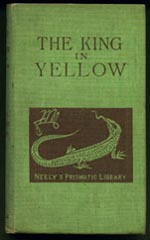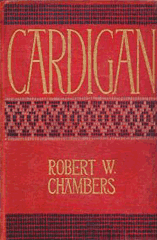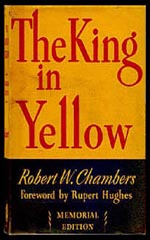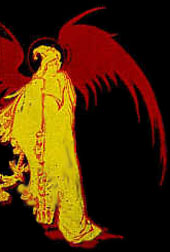Lovecraft was always proud
to say he was influenced by the great writers of the eighteenth and
nineteenth century. He was less likely to admit it but the lesser writers
of his youth had an equal or greater influence. One of these was Robert
W. Chambers, a painter turned author who published his greatest work
of horror when Lovecraft was only five. But it was reprinted numerous
times within his life and HPL spoke of it fondly. In a way, Chambers
betrayed Lovecraft by giving up horror and becoming on of the most successful
writers of popular fictions of the first two decades of the twentieth
century.
Though fame in his lifetime came
from his succession of best-selling "shop-girl" society romances and
historical novels, Robert William Chambers (1865-1933) is perhaps
best remembered today for his horror and fantasy stories. In his day,
his historical and romance novels earned him the title "the Shopgirl
Scheherazade" and "the barker of the New York society side show."
H. L. Menken called him "the Boudoir Balzac." But even within his
lifetime the audience for such books fell away with the new literature
of the twenties and thirties and the coming of the second world war.
Robert William Chambers was born
in Brooklyn on May 26, 1865, to William P. Chambers (1827 -
1911), a famous lawyer, and Caroline Chambers (née Boughton),
a direct descendant of Roger Williams, the founder of Rhode Island.
It was a family of wealth and social standing and the children were
expected to excel. Robert's brother was Walter Boughton Chambers,
the world famous architect.
 Chambers
was educated at the Brooklyn Polytechnic Institute. There, and at
his grandfather's estate in the Adirondacks, he discovered in his
love of nature and outdoor sportsmanship a talent for drawing.
Chambers
was educated at the Brooklyn Polytechnic Institute. There, and at
his grandfather's estate in the Adirondacks, he discovered in his
love of nature and outdoor sportsmanship a talent for drawing.
At twenty, he studied painting
at the Art Students' League in New York where he became friends with
another student, Charles Dana Gibson, later to gain fame as a magazine
and book illustrator. There is a legend that the young Chambers
and Gibson took sketches to the editor of Life, then a humor
magazine, looking for their first job. The editor accepted Chambers's
work and turned down Gibson so scornfully that Gibson resolved never
to submit a drawing again.
At 21, in 1886, he went to Paris
for seven years to study at the École des Beaux Arts and, later,
the Julien Academy. He studied under Cormon, Lefebvre, Boulanger,
Collin, and Doucet. He first exhibited in the Paris salon in 1889.  He
returned to New York in 1893 and began selling illustrations to Life,
Truth, Vogue, and other magazines.
He
returned to New York in 1893 and began selling illustrations to Life,
Truth, Vogue, and other magazines.
Chambers published his first
book, In the Quarter (1894), a melodrmatic tale of student
life in Paris published as an anonymous volume. He had originally
written it in Munich in 1887. It appeared in an anonymous edition.
One critic said "it might yield a libretto for another 'La Bohême.'"
Its success was enough to inspire a second work and it was the second
literary work that really took off and changed the young man's life.
It even encouraged his publisher to re-release In the Quarter
with the author's name and reference to the second work.
In 1895, Chambers published a
remarkable collection of ten eerie short stories, The King in
Yellow. It appeared during a period when a lot of people unlikely
to writer horror stories did so. Perhaps inspired by success of Ambrose
Bierce, the rise of spiritualism, or the impending turn of a century
which often creates emotional and spritual uncertainty, architect
Ralph Adams Cram wrote his collection of ghost stories entitled Black
Spirits and White (1895), historical novelist F. Marion Crawford
wrote "The Upper Berth" (1894), humorist W. W. Jacobs wrote
the horrific story "The Monkey's Paw," Henry James wrote The
Turn of the Screw, and children's book author Mrs. Nesbit
wrote Grim Tales (1893).
 The
King in Yellow is the most striking of all collected horror
story works in that the title refers to a fictional play which becomes
in integral part of a number of stories which are otherwise unrelated.
The play "The King in Yellow"
to which the title refers is said to drive those who read it
insane. The first four stories, "The Repairer
of Reputations," "The Mask," "In the Court of the Dragon,"
and "The Yellow Sign," concern people who have come across
copies of the rare and banned play. Horrific tragedy strikes all who
remain sane after reading it. The middle two tales are a classic ghost
story and a poetic, mystical trifle. The last four tales harken back
to Chambers's first novel, revolving around the Paris student art
scene but all involve some small, eerie twist.
The
King in Yellow is the most striking of all collected horror
story works in that the title refers to a fictional play which becomes
in integral part of a number of stories which are otherwise unrelated.
The play "The King in Yellow"
to which the title refers is said to drive those who read it
insane. The first four stories, "The Repairer
of Reputations," "The Mask," "In the Court of the Dragon,"
and "The Yellow Sign," concern people who have come across
copies of the rare and banned play. Horrific tragedy strikes all who
remain sane after reading it. The middle two tales are a classic ghost
story and a poetic, mystical trifle. The last four tales harken back
to Chambers's first novel, revolving around the Paris student art
scene but all involve some small, eerie twist.
In his treatise The Supernatural
in Literature Lovecraft wrote of Chambers's work: "Very genuine,
though not without the typical mannered extravagance of the eighteen-nineties,
is the strain of horror in the early work of Robert W. Chambers, since
renowned for products of a very different quality. The King
in Yellow, a series of vaguely connected short stories having
as a background a monstrous and suppressed book whose perusal brings
fright, madness and spectral tragedy, really achieves notable heights
of cosmic fear in spite of uneven interest and a somewhat trivial
and affected cultivation of the Gallic studio atmosphere made popular
by Du Maurier's Trilby."
And the collection has been recognized
for its value. The King in Yellow has often been repeatedly
reprinted and anthologized to the present day.
This this success, Chambers dropped
his artistic career and turned to writing. The Woman's Movement
and the typewriter were changing the social structure of America as
young women entered the workplace, sought respectability in business,
and earned there own disposable income. A great deal of this
income would go toward the purchase of Chambers novels. Chambers
spoke to the romantic and social needs of these women. For the
next few years he alternated between fantastic fiction - The
Maker of Moons (1896), The Mystery of Choice
(1897) - and historical novels - The Red Republic, 1894;
Lorraine, 1896; Ashes of Empire, 1897.
This series of four romances centered around the Franco-Prussian War
(including The Maids of Paradise, 1903) was began
at the same time he was writing The King in Yellow.
As with his later historical novels, these all have young American
as their heroes. In Ashes of Empire a group of dashing
young Americans assist the Empress Eugénia to escape, hat and
all, from Paris.
 After
the Franco-Prussian novels, he tackled the American Revolution
with his most famous novel, Cardigan, 1901 followed
by The Maid-at-Arms, 1902; The Hidden Children,
1914; The Little Red Foot, 1921.
After
the Franco-Prussian novels, he tackled the American Revolution
with his most famous novel, Cardigan, 1901 followed
by The Maid-at-Arms, 1902; The Hidden Children,
1914; The Little Red Foot, 1921.
In reaching this young audience
Chambers helped create the image of young Americans in the new century.
The working woman was for a short time called "the Chambers Girl."
This was quickly supplanted by Chambers's friend Charles Dana Gibson,
who illustrated the majority of the Chambers society novels, used
his own merchandising skills to promote "the Gibson Girl." It
was often said that while Gibson helped create a visual look for the
newly emerging, turn-of-the-century working woman, Chambers, in his
society novels, gave her a voice.
On July 12, 1898, Chambers married Elsa Vaughn Moller
(1882 - 1939). They had a son, Robert Edward Stuart Chambers
(later calling himself Robert Husted Chambers) who also gained some
fame as an author.[1] At a New York office, whose address was
unknown even to his family, Robert W. Chambers wrote from ten to six.
The family split their time between New York and a luxurious house
in Broadalbin, New York at the foot of the Adirondack Mountains.
Fishing and hunting were his relaxations. The novelist was a well
set-up man, with square shoulders and chin and a gray mustache. His
manner was cordial and genial. Robert and Elsie were active
members of New York society as can be seen by Elsie's 1910 gift to
the Metropolitan Museum of Art of The Old Mill (Vieux Moulin) [ca.
1892] by American impressionist Theodore Robinson (1852-1896)
 [1] Note. Robert Husted Chambers: The change to "Husted" may
have come from one of his father's novels: the 1902 novel The
Maids-at-Arms was dedicated to Miss Katharine Husted.
As a young boy around 1912 Lena Dalkeith dedicated her book "Stories
from Roman History" to him and a Robert Husted Chambers short story
Captain Sebastien appeared in the December 1922.
[1] Note. Robert Husted Chambers: The change to "Husted" may
have come from one of his father's novels: the 1902 novel The
Maids-at-Arms was dedicated to Miss Katharine Husted.
As a young boy around 1912 Lena Dalkeith dedicated her book "Stories
from Roman History" to him and a Robert Husted Chambers short story
Captain Sebastien appeared in the December 1922.
A New York socialite himself,
in 1906 Chambers turned to contemporary society with six novels beginning
with The Fighting Chance (1906) and concluding with
The Streets of Ascalon (1912) and including four others.
These took on topical subjects like love and the class and monetary
obstacles of marriage, the dangers of alcohol, and the guestion of
divorce. In these novels, usually illustrated by Charles Dana Gibson,
Chambers showed the weakness he, and Gibson, had in understanding
the emergence of the independent woman. This did not stop women from
flocking to read his novels but a later critic could remark that "despite
the vogue for the Chambers heroine at the time, she was markedly less
convincing than his men."
Throughout his career, Chambers
would often return to horror, often mixing it delightfully with mystery
and action in the vein of Sax Rohmer. Some of the best include In
Search of the Unknown (1904) and The Slayer of Souls
(1920).
In his first twenty years as a popular writer, Robert
W. Chambers produced forty-five volumes, “veering in accordance with
the breeze of popular demand.” According to some estimates, Chambers
was one of the most successful literary careers of his period, his
later novels selling well and a handful achieving best-seller status.
Many of his works were also serialized in magazines.
The period of 1915-1919 had its quota of war novels.
In 1924 he returned to historical fiction, with the
same easy fluency but small critical acclaim, although magazines continued
to pay high prices for his serials.
A critic said of his historical
novels that they, "exhibited his ability to handle crowds, invent
exciting incident, and exercise his painter's dexterity in painting
vivid landscapes." A typical example of his descriptive powers can
be found in a passage from "The White Shadow" (The Mystery
of Choice):
Then the daily repeated
miracle of the coming of dawn was wrought before our eyes. The heavens
glowed in rainbow tints; the shredded mist rising along the river
was touched with purple and gold, and acres of meadow and pasture
dripped precious stones. Shreds of the fading night-mist drifted among
the tree tops, now tipped with fire, while in the forest depths faint
sparkles came from some lost ray of morning light falling on wet leaves.
Then of a sudden upshot the sun, and against it, black and gigantic,
a peasant towered, leaning upon his spade.
And Chambers knew how to write for
his audience. "I write the sort of stories," says Chambers, quoted in
Authors Today and Yesterday, "which at the moment it amuses me to write;
I trust to luck that it may also amuse the public." And they liked it.
He was a top selling author of genre novels, often on the best seller
list, and increasingly wealthy from his craft. An enclopedia of
the time said, that "despite his years, Mr. Chambers already ranks among
the foremost writers of romantic fiction. His style has been compared
to Anthony Hope, but although both these brilliant writers deal with
the same class of subjects and characters Mr. Chambers discovers an
individuality and originality which sufficiently differentiate him from
any others of his school."
"I have always liked to change,
to experiment--just as I used to like to change my medium in painting,
aquarelle, oil, charcoal, wast, etc," he said and proved it by alternating
between novels, short stories, poems, magazine articles of natural
history, military subjects, and hunting and fishing, and novels. For
the actress Ada Rehan he wrote a play, The Witch of Ellangowan,
it is said, in one weeks' time. It was produced at Daly's Theatre
in New York city during the spring of 1897. His musical comedy Iole,
made from his novel of that title, was produced in New York in 1913.
His historical novels, already covering the Franco-Prussian War and
the American Revolution, went on to include a series on World War
One, the War of 1812, The Civil War, and the French and Indian Wars.
He even wrote a novel about Captain Kidd, The Man they Hanged.
His 1906 novel The Tracer of Lost Persons provided the
basis for the long-running radio series "Mr. Keen, Tracer of Lost
Persons" from which many television series took inspiration.
But like many popular novelists,
Chambers became increasingly a man of leisure, pounding out his novels
to pay for his real pleasures. In town he was a popular club man,
a member of the National Institute of Arts and Letters and belonged
to a wide number of clubs: the Century Club (like his father before
him), the Metropolitan Club, the Authors' Club (New York), Triple
Island, Broadalbin Game, Union, Saratoga Golf, Rockwood Hall, and
the Calumet Club of New York among others.
Authors Today and Yesterday
says: "During the winter months Chambers lives in New York City and
has an office, the location of which not even his family knows. Here
he writes daily from ten to six, secure from distraction. He says
his stories have the most erratic way of developing. 'Sometimes I
begin with the last chapter, sometimes in the middle, and sometimes
I lay out an elaborate skeleton. The despair of my publisher is this
uncertainty of working method. I have sometimes written thirty thousand
words, waited two weeks to decide what should happen next, and torn
up the whole thirty thousand to get rid of the dilemma. It was much
easier for me to do that than to doctor the manuscript.'"
His work in town was a seasonal
affair. Every summer, Chambers and his family would retreat to the
family estate in Broadalbin, New York, in the foothills of the Adirondacks.
The house, built early in the nineteenth century by his grandfather,
Dr. William Chambers, was rebuilt for him by his brother, Walter Boughton
Chambers, the architect.  Chambers
and his wife filled the house with Chinese and Japanese antiques,
medieval armor, and rare rugs. On the eight hundred acres Chambers
could pursue his love of nature, hunting with his dog, fishing, collecting
butterflies, and riding horses. He was, rare for his time, an ecologist,
an avid planter of trees (20,000 it is said).
Chambers
and his wife filled the house with Chinese and Japanese antiques,
medieval armor, and rare rugs. On the eight hundred acres Chambers
could pursue his love of nature, hunting with his dog, fishing, collecting
butterflies, and riding horses. He was, rare for his time, an ecologist,
an avid planter of trees (20,000 it is said).
After 1924, Chambers devoted
himself exclusively to historical subject. Though a good deal of his
audience had deserted him, he continued to write with the same "easy
fluency but to small critical acclaim, although magazines continued
to pay high prices for his serials." Chambers died in New York City
on December 16, 1933 following abdominal surgery.
Chambers had 14 of his works turned into movies in
his lifetime. One of his books, The Common Law, was filmed three times.
Chambers has always traveled with the rich and powerful, we see that
in his books.  That
he knew Rupert Hughes, the uncle of Howard Hughes, is a fact. Rupert
Hughes wrote the 1933 introduction to the memorial re-issue of The
King in Yellow.
That
he knew Rupert Hughes, the uncle of Howard Hughes, is a fact. Rupert
Hughes wrote the 1933 introduction to the memorial re-issue of The
King in Yellow.
Ultimately, after his death his critics looked down
on his body of work. H.P. Lovecraft said of him in a letter
to Clark Ashton Smith, "Chambers is like Rupert Hughes and a few other
fallen Titans - equipped with the right brains and education but wholly
out of the habit of using them." Frederic Taber Cooper commented,
"So much of Chambers's work exasperates, because we feel that he might
so easily have made it better." As a writer he exhibited his
ability to handle crowds, invent exciting incident, and exercise his
painter’s dexterity in painting vivid landscapes.
 It
is an interesting contrast between Chambers and Lovecraft. While Lovecraft
thought highly of Chambers's early horror stories and abhorred the
later work as selling out, Robert W. Chambers is almost exactly the
writer Lovecraft dreamed of being: the Gentleman Writer. Lovecraft
repeatedly spoke of his desire to be able to live comfortably, write
as he pleased while living off the profits of that writing, and pursuing
the gentlemanly pleasures of sport, scienific knowledge, and collecting.
He aspired to be a Lord Dunsany. Though Chambers did not have a title,
he had more in common with Dunsany than Lovecraft in everything but
dedication of horror and fantasy.
It
is an interesting contrast between Chambers and Lovecraft. While Lovecraft
thought highly of Chambers's early horror stories and abhorred the
later work as selling out, Robert W. Chambers is almost exactly the
writer Lovecraft dreamed of being: the Gentleman Writer. Lovecraft
repeatedly spoke of his desire to be able to live comfortably, write
as he pleased while living off the profits of that writing, and pursuing
the gentlemanly pleasures of sport, scienific knowledge, and collecting.
He aspired to be a Lord Dunsany. Though Chambers did not have a title,
he had more in common with Dunsany than Lovecraft in everything but
dedication of horror and fantasy.
But Lovecraft also hated dogs,
sloppy writing, and romantic plot lines. Chambers loved hunting dogs,
a beautiful and often half-naked woman in his plot lines, and didn't
seem to mind a bit if the critics thought he was too flowery in his
description (often excellent but extended). It is a tragedy that his
lurid and gory serialized story The Slayer of Souls
was printed in book form without removing the repetitive updating
of plot line every few chapters. But he lived a full and happy life.
That seemed to be what he was after. And he has left the world with
a dozen or more brilliant novels and tales out of his vast production
of over seventy works. For who is there who can write passages describing
fear and desolation as well today as Chambers in "The Repairer
of Reputations":
"This
is the thing that troubles me, for I cannot forget Carcosa where black
stars hang in the heavens; where the shadows of men's thoughts lengthen
in the afternoon, where the twin suns sink into the Lake of Hali;
and my mind will bear forever the memory of the Pallid Mask. I pray
God will curse the writer, as the writer has cursed the world with
this beautiful, stupendous creation, terrible in its simplicity, irresistible
in its truth a world which now trembles before the King in Yellow."



